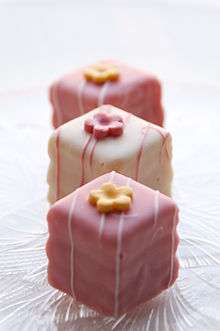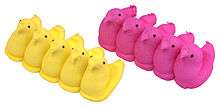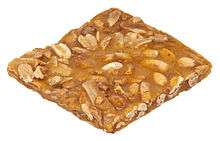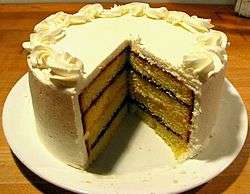Confectionery

Confectionery,[1][2][3][4] also called sweets or candy, is sweet food. The term varies among English-speaking countries.[5] In general, though, confectionery is divided into two broad and somewhat overlapping categories, bakers' confections and sugar confections.[6]
Bakers' confectionery, also called flour confections, includes principally sweet pastries, cakes, and similar baked goods. In the Middle East and Asia, flour-based confections are more dominant.
Sugar confectionery includes sweets, candied nuts, chocolates, chewing gum, sweetmeats, pastillage, and other confections that are made primarily of sugar. In some cases, chocolate confections (confections made of chocolate) are treated as a separate category, as are sugar-free versions of sugar confections.[7] The words candy (US and Canada), sweets (UK and Ireland), and lollies (Australia and New Zealand) are common words for the most common varieties of sugar confectionery.
The confectionery industry also includes specialized training schools and extensive historical records.[8] Traditional confectionery goes back to ancient times, and continued to be eaten through the Middle Ages into the modern era.
Nutrition
Generally, confections are low in micronutrients and protein but high in calories. They may be fat-free foods, although some confections, especially fried doughs, are high-fat foods. Many confections are considered empty calories.
Specially formulated chocolate has been manufactured in the past for military use as a high-density food energy source.
Sweetening agents
Confections are defined by the presence of sweeteners. These are usually sugars, but it is possible to buy sugar-free sweets, such as sugar-free peppermints. The most common sweetener for home cooking is table sugar, which is chemically a disaccharide called sucrose. Hydrolysis of sucrose gives a mixture called invert sugar, which is sweeter and is also a common commercial ingredient. Finally confections, especially commercial ones, are sweetened by a variety of syrups obtained by hydrolysis of starch. These sweeteners include all types of corn syrup.[9]
Bakers' confectionery

Bakers' confectionery includes sweet baked goods, especially those that are served for the dessert course. Bakers' confections are sweet foods that feature flour as a main ingredient and are baked. Major categories include cakes, sweet pastries, doughnuts, scones, and cookies.[10]
Sugar confectionery
Sugar confections include sweet, sugar-based foods, which are usually eaten as snack food. This includes sugar candies, chocolates, candied fruits and nuts, chewing gum, and sometimes ice cream.
The United Nations' International Standard Industrial Classification of All Economic Activities (ISIC) scheme (revision 4) classifies both chocolate and sugar confectionery as ISIC 1073, which includes the manufacture of chocolate and chocolate confectionery; sugar confectionery proper (caramels, cachous, nougats, fondant, white chocolate), chewing gum, preserving fruit, nuts, fruit peels, and making confectionery lozenges and pastilles.[11] In the European Union, the Statistical Classification of Economic Activities in the European Community (NACE) scheme (revision 2) matches the UN classification, under code number 10.82. In the United States, the North American Industry Classification System (NAICS 2012) splits sugar confectionery across three categories: National industry code 311340 for all non-chocolate confectionery manufacturing, 311351 for chocolate and confectionery manufacturing from cacao beans, and national industry 311352 for confectionery manufacturing from purchased chocolate.[12] Ice cream and sorbet are classified with dairy products under ISIC 1050, NACE 10.52, and NAICS 311520.[13]
Different dialects of English use regional terms for sugar confections:
- In Britain, Ireland, and some Commonwealth countries, sweets or, more colloquially, sweeties (particularly used by children, the Scottish Gaelic word suiteis is a derivative).
- In Australia and New Zealand, lollies. Chewy and Chuddy are Australian slang for chewing gum.[14]
- In North America, candy, although this term generally refers to a specific range of confectionery and does not include some items of sugar confectionery (e.g. ice cream). Sweet is occasionally used, as well as treat.
Examples



Sugar confectionery items include sweets, lollipops, candy bars, chocolate, cotton candy, and other sweet items of snack food. Some of the categories and types of sugar confectionery include the following:[9]
- Caramels: Derived from a mixture of sucrose, glucose syrup, and milk products. The mixture does not crystallize, thus remains tacky.
- Chocolates: Bite-sized confectioneries generally made with chocolate.
- Divinity: A nougat-like confectionery based on egg whites with chopped nuts.
- Dodol: A toffee-like food delicacy popular in Indonesia, Malaysia, and the Philippines
- Dragée: Sugar-coated almonds and other types of sugar panned candy.
- Fondant: Prepared from a warm mixture of glucose syrup and sucrose, which is partially crystallized. The fineness of the crystallites results in a creamy texture.
- Fudge: Made by boiling milk and sugar to the soft-ball stage. In the US, it tends to be chocolate-flavored.
- Halvah: Confectionery based on tahini, a paste made from ground sesame seeds.
- Hard candy: Based on sugars cooked to the hard-crack stage. Examples include suckers (known as boiled sweets in British English), lollipops, jawbreakers (or gobstoppers), lemon drops, peppermint drops and disks, candy canes, rock candy, etc. Also included are types often mixed with nuts such as brittle. Others contain flavorings including coffee such as Kopiko.
- Ice cream: Frozen, flavoured cream, often containing small pieces of chocolate, fruits and/or nuts.
- Jelly candies: Including those based on sugar and starch, pectin, gum, or gelatin such as Turkish delight (lokum), jelly beans, gumdrops, jujubes, gummies, etc.[15]
- Liquorice: Containing extract of the liquorice root. Chewier and more resilient than gum/gelatin candies, but still designed for swallowing. For example, Liquorice allsorts. Has a similar taste to star anise.
- Marshmallow: "Peeps" (a trade name), circus peanuts, fluffy puff, Jet-Puffed Marshmallows etc.
- Marzipan: An almond-based confection, doughy in consistency, served in several different ways.
- Mithai: A generic term for confectionery in India, typically made from dairy products and/or some form of flour. Sugar or molasses are used as sweeteners.
- Tablet: A crumbly milk-based soft and hard candy, based on sugars cooked to the soft ball stage. Comes in several forms, such as wafers and heart shapes. Not to be confused with tableting, a method of candy production.
- Taffy or chews: A candy that is folded many times above 120 °F (50 °C), incorporating air bubbles thus reducing its density and making it opaque.
- Toffee: a confection made by caramelizing sugar or molasses along with butter. Toffee has a glossy surface and textures ranging from soft and sticky to a hard, brittle material. Its brown color and smoky taste arises from the caramelization of the sugars.
Cultural roles
.jpg)
Both bakers' and sugar confections are used to offer hospitality to guests.
Confections are used to mark celebrations or events, such as a wedding cake, birthday cake or Halloween.
Tourists commonly eat confections as part of their travels. The indulgence in rich, sugary foods is seen as a special treat, and choosing local specialties is popular. For example, visitors to Vienna eat Sachertorte and visitors to seaside resorts in the UK eat Blackpool rock candy. Transportable confections like fudges and tablet may be purchased as souvenirs.[16]
Risks
Excessive consumption of confectionery has been associated with increased incidences of type 2 diabetes, obesity, and tooth decay.[17]
Contaminants and coloring agents in confectionery can be particularly harmful to children. Therefore, confectionery contaminants, such as high levels of lead, have been restricted to 1 ppm in the US. There is no specific maximum in the EU.[18]
Candy colorants, particularly yellow colorants such as E102 Tartrazine, E104 Quinoline Yellow and E110 Sunset Yellow FCF, do have many restrictions around the world. Tartrazine, for example, can cause allergic and asthmatic reactions and was once banned in Austria, Germany, and Norway. Some countries such as the UK have asked the food industry to phase out the use of these colorants, especially for products marketed to children.[19]
See also
References
- ↑ https://www.oxforddictionaries.com/definition/english/confectionery
- ↑ https://www.oxfordlearnersdictionaries.com/definition/english/confectionery
- ↑ https://dictionary.cambridge.org/dictionary/english/confectionery
- ↑ http://www.ldoceonline.com/dictionary/confectionery
- ↑ https://www.britannica.com/topic/candy-food
- ↑ International Food Information Service, ed. (2009). Dictionary of Food Science and Technology (2nd ed.). Chichester, U.K.: Wiley–Blackwell. p. 106. ISBN 9781405187404.
- ↑ Edwards, W.P. (2000). The Science of Sugar Confectionery. Cambridge: Royal Society of Chemistry. p. 1. ISBN 9780854045938.
- ↑ http://www.historicfood.com/The%20Art%20of%20Confectionery.pdf
- 1 2 Terry Richardson, Geert Andersen, "Confectionery" in Ullmann's Encyclopedia of Industrial Chemistry 2005 Wiley-VCH, Weinheim. doi:10.1002/14356007.a07 411
- ↑ International Food Information Service, ed. (2009). Dictionary of Food Science and Technology (2nd ed.). Chichester, U.K.: Wiley–Blackwell. p. 39. ISBN 9781405187404.
- ↑ "ISIC Rev.4 code 1073: Manufacture of cocoa, chocolate and sugar confectionery". United Nations Statistics Division, Classification Registry. 2014. Retrieved 18 June 2014.
- ↑ "Correspondences for ISIC Rev.4 code 1073". United Nations Statistics Division. 2014.
- ↑ "Correspondences for ISIC Rev.4 code 1050". United Nations Statistics Division. 2014. Retrieved 18 June 2014.
- ↑ "Definition of chuddy Oxford dictionary (British & World English)", www.oxforddictionaries.com, 2014, retrieved 15 July 2014
- ↑ Margaret McWilliams. (2006) Nutrition and Dietetics Eighth edition edn. Prentice Hall: Pearson Education Inc.
- ↑ Cleave, Paul (2012). "Sugar in Tourism: 'Wrapped in Devonshire Sunshine'". Sugar Heritage and Tourism in Transition. Channel View Publications. pp. 159–172. ISBN 9781845413897.
- ↑ Magee, Elaine; "Sugar: What Kinds to Eat and When" WebMD.com (Health & Cooking), 28 January 2009 (Retrieved: 11 July 2009)
- ↑ EFSA Scientific Opinion on Lead in Food European Food Safety Authority (EFSA), Retrieved 13 November 2012
- ↑ Ministers agree food Color ban BBC News, Retrieved 14 November 2012
Further reading
- García Ballesteros, Enrique (2012). Foods From Spain History: Bakery & Confectionery. A Taste For Sweetness.
- Goldstein, Darra (2015). The Oxford Companion to Sugar and Sweets. Oxford University Press. ISBN 978-0-19-931339-6.
- Kennedy, Angus (2008). Kennedy's Confection Magazine.
- Richardson, Tim H. (2002). Sweets: A History of Candy. Bloomsbury USA. ISBN 1-58234-229-6.
- Stroud, Jon (2008). The Sucker's Guide: A Journey into the Soft Centre of the Sweet Shop. Summersdale. ISBN 978-1-84024-709-1.
- Weatherley, Henry (1865). A Treatise on the Art of Boiling Sugar. Retrieved 14 July 2008.
External links
| Look up confectionery in Wiktionary, the free dictionary. |
| Wikimedia Commons has media related to confectionery. |
| Wikibooks Cookbook has a recipe/module on |
